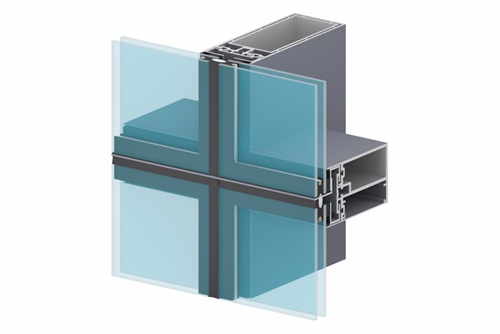Exposed frame and hidden frame play a key role in the way curtain walls define the aesthetics and functionality of a building. These non-structural curtain wall systems are designed to protect the interior from the elements while providing open views and natural light. Of the various types of curtain walls, exposed frame and hidden frame curtain walls are two popular options often considered by architects and builders. In this blog, we will explore the differences between these two types of curtain walls.
Structural Characteristics
Exposed Frame Curtain Wall: It has a distinct aluminium or steel frame in which the glass panels are fixed by means of sealing strips or sealants. The horizontal and vertical bars of the frame divide the glass panels into a number of cells, forming a regular grid pattern. This structural form makes the installation and replacement of glass more convenient, while the frame also plays a certain protective role, improving the overall stability of the curtain wall.
Hidden Frame Curtain Wall: Its aluminium frame is hidden behind the glass panel, and the frame is not visible from the outside. The glass panel is directly pasted on the sub-frame through structural adhesive, and the sub-frame is then fixed by mechanical connection or structural adhesive with the connectors of the main structure. The structure of the hidden frame curtain wall is relatively simple, and can show the translucent texture of the glass to the greatest extent, making the appearance of the building more concise and smooth.


Appearance Effect
Exposed Frame Curtain Wall: Due to the existence of the frame, the appearance shows obvious horizontal and vertical lines, giving people a sense of regularity and stability. The colour and material of the frame can be selected according to the design requirements, in order to meet the needs of different architectural styles and decorative effects. The line sense of exposed frame curtain wall makes it more widely used in some buildings with modernism or classicism style, which can enhance the three-dimensional sense and hierarchy of the building.
Hidden Frame Curtain Wall: The frame is almost invisible in appearance, and the glass surface is flat and smooth, which can realize the effect of large continuous glass, making the building appearance more simple and atmospheric, with a strong sense of modernity and transparency. This form of curtain wall is particularly suitable for the pursuit of pure and simple architectural design, which can create a stylish, high-end image for the building.
Performance
Waterproof Performance: The waterproof of exposed frame curtain wall mainly relies on the sealing line formed between the frame and the glass by the sealing tape or sealant. Its waterproof principle is relatively direct, as long as the quality of the sealing tape or sealant is reliable and installed correctly, it can effectively prevent rainwater infiltration. The hidden frame curtain wall waterproofing is relatively complex, in addition to the structural adhesive sealing between the glass and the sub-frame, but also need to do a good job in the sub-frame and the main structure of the joints and other parts of the waterproofing treatment, in order to ensure that the overall waterproof performance of the curtain wall.
Airtightness: The airtightness of the exposed frame curtain wall mainly depends on the sealing effect between the frame and the glass as well as the sealing performance of the frame's own splicing. Due to the existence of the frame, its airtightness is relatively easy to control and ensure. The airtightness of the hidden frame curtain wall mainly depends on the bonding quality and sealing performance of the structural adhesive, if the structural adhesive construction quality is poor or there are aging, cracking and other problems, it may affect the airtightness of the curtain wall.
Wind Resistance: The frame of exposed frame curtain wall can provide better support and constraint for the glass, which enhances the overall wind resistance of the curtain wall. Under the action of strong wind, the frame can share part of the wind load and reduce the pressure on the glass. Since the glass of hidden frame curtain wall is directly pasted on the sub-frame, its wind resistance mainly depends on the bonding strength of the structural adhesive and the thickness of the glass and other factors. When designing and constructing, it is necessary to reasonably select the glass thickness and structural adhesive type according to the wind load situation of the region where the building is located, so as to ensure the wind safety of the curtain wall.

Choosing between exposed frame and hidden frame curtain walls ultimately depends on the specific needs of the project, including aesthetic preferences, structural requirements, and energy efficiency goals. Both types of curtain walls have their own unique benefits and applications that make them important choices for modern architecture. By understanding the differences between these two systems, architects and builders can make informed decisions to enhance the functionality and aesthetics of their designs. Please contact info@gkbmgroup.com for your exclusive customisation.
Post time: Nov-01-2024




